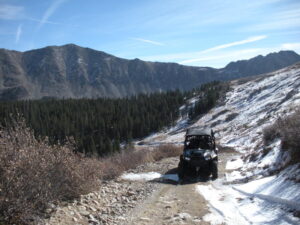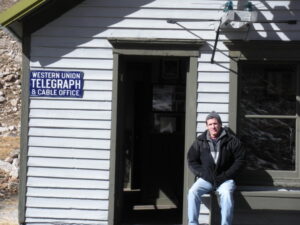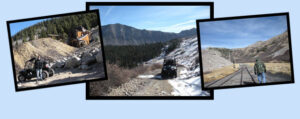Reaching the Summit of Hancock Pass in Colorado
Colorado has some of the most beautiful mountain passes in the world. Add the vast amount of history that is littered thorough out the entire area and the exploring is endless.
By Jim Brown and Mike Tavernier
Located approximately 8 miles south of Buena Vista, Colorado is Country Road 162. Take County Road 162 west for 15 miles to the Hancock Pass trail head (Google Maps).
The trail begins at 10,003 ft (GPS) as a smooth dirt road (Forest Road 295) until you reach the Hancock town site. The town no longer exists, but markers and signs identify some of the history from the past. There are three choices to continue, Hancock Lake, Hancock Pass, or you can park and hike to the East Portal of the Alpine Tunnel.
Our destination was over Hancock Pass (Forest Road 299) and the West Portal of the Alpine Tunnel. As we began up the trail, the terrain became increasingly rocky with areas of light snow on the trail. Coming out of the trees, we began to climb hard on our way up to the top of the pass and 12,140 ft. It was windy and 29 degrees at the top!
We began our descent and came turned onto Forest Road 839. We traveled up the railroad grade trail until we reached the gate to the Alpine Tunnel 11,518 ft (GPS). The gate is to keep vehicles from disturbing what remains of the history. We took our lunch and walked to the Alpine Tunnel Station. The door was unlocked and there was a guest book on a desk so people can sign in. There were three rooms with two having operational wood burning stoves and one had a bed, with no mattress. There was even kindling next to the stove and wood stored in a closet. The walls were full of history complete with pictures and newspaper articles in an enclosed case.
After lunch we walked what remained of the tracks and rounded the corner to see the Alpine Tunnel entrance. It was clear after looking that the Tunnel had caved in many years ago.
History of the Hancock Townsite
Hancock served the workers who built the famous Alpine Tunnel. Its main population peak was in the 1880’s and 1890’s while the tunnel was being built. Mining was secondary in Hancock. The tunnel was completed in 1881, but the train ran through Hancock carrying miners, passengers and supplies. It is said Mark Twain took the ride one time just for the experience. The tunnel ceased operation in 1910 and the last mine in Hancock closed in 1926 with the passing of the last passenger train. Today one can still make it to the Alpine Tunnel entrance in a 4WD.
History of the Alpine Tunnel
Once the highest railroad tunnel in the world, at an altitude of 11,523 feet, it was the first tunnel to be built through the Continental Divide. The Denver, South Park and Pacific Railroad began the work of connecting St. Elmo to Pitkin, Colorado in November, 1879 with a construction crew working at either end to connect the line. Anticipating that the mineral rich area would be the next big mining “bonanza,” as many as 10,000 different men worked to build the line and the tunnel at various times. A crew of around 400 worked steadily, but turnover was quick, as the men suffered through the cold, brutal work. Laborers, working for $3.50 per day, and explosives men, who worked for $5.00 per day, were often forced to go from their worksite to their cabins in groups in order to avoid being lost in the snow.
Excavation of the tunnel began in January, 1880 with plans to complete it within six months. But, those were ambitious plans, especially starting the project in the middle of winter. It would actually take the railroad more than two years to complete the tunnel and cost them far more than they had planned, coming in at about $300,000 and some $180,000 more than they had initially budgeted. Due to crumbling granite in the tunnel, over 400,000 board feet of California redwood was required to support and encase 80% of it.
The two crews met each other in the tunnel in July, 1881, but it would be another year before it was ready for the train.
When the first narrow gauge train came through in July, 1882, the tunnel was 1, 772 feet long, over two miles above sea level, 500 feet below Altman Pass (later renamed Alpine Pass) and the most expensive railroad tunnel built up until that time.
Beyond the west portal exit of the tunnel, stood the alpine Tunnel Station, the highest railroad station in the nation; as well as a turntable, water tank, stone boarding house, and engine house that was large enough to house six engines.
More information on the Alpine Tunnel can be found here.
Jim’s 2008 Polaris RZR
- IPT ss108 Rims
- Maxxis Big Horn Tires
- Maier Hood Scoop
- Factory UTV UHMW Skid Plate
- Gorilla 3000# Winch
- UTV Crap Kor 2” Wheel Spacers
- Pure Polaris Rock Slider Nerfs
- Pure Polaris Headache Net
- Pure Polaris Rear View Mirror
- Polaris Lock-n-Ride Cargo Box
- Pure Polaris Gas Can Holder
- Pure Polaris Flame Decals
- Pure Polaris Under dash Storage Bag
- Pure Polaris RZR “S” Flares
- Pure Polaris Seat Adjustment
- Lonestar Intake Grille
- Tusk RZR Soft Top
- Super ATV Overhead Map Storage
- Super ATV Billet Dash Switch Plate
- Rear Frame Gusset
Category: Featured, Polaris, Trail Rides















Thanks to Jon Crowley for putting this article together!